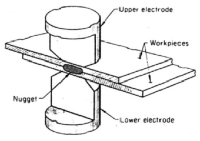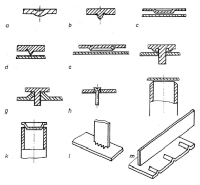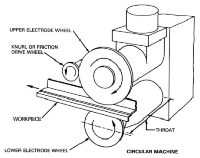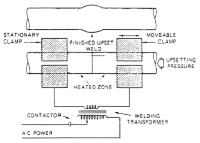Resistance Welding Processes
Resistance welding is a welding technology widely used in manufacturing
industry for joining metal sheets and components. The weld is made
by conducting a strong current through the metal combination to
heat up and finally melt the metals at localized point(s) predetermined
by the design of the electrodes and/or the workpieces to be welded.
A force is always applied before, during and after the application
of current to confine the contact area at the weld interfaces and,
in some applications, to forge the workpieces.
Depending on the shape of the workpieces and the form of the electrodes,
resistance welding processes can be classified into several variants
as described below:
 Resistance
Spot Welding Resistance
Spot Welding
Spot welding is a resistance welding process for joining metal sheets
by directly applying opposing forces with electrodes with pointed
tips. The current and the heat generation are localized by the form
of the electrodes. The weld nugget size is usually defined by the
electrode tip contact area.
Spot welding is the predominant joining process in automotive
industry for assembling the automobile bodies and large components.
It is also widely used for manufacturing of furniture and domestic
equipment etc.
 Resistance
Projection Welding Resistance
Projection Welding
Projection welding is a resistance welding process for joining metal
components or sheets with embossments by directly applying opposing
forces with electrodes specially designed to fit the shapes of the
workpieces. The current and the heat generation are localized by
the shape of the workpieces either with their natural shape or with
specially designed projection. Large deformation or collapse will
occur in the projection part of the workpieces implying high process/machine
dynamics.
Projection welding is widely used in electrical, electronics,
automotive and construction industries, and manufacturing of sensors,
valves and pumps etc.
 Resistance
Seam Welding Resistance
Seam Welding
Seam welding is a resistance welding process for joining metal sheets
in continuous, often leak tight, seam joints by directly applying
opposing forces with electrodes consisting of rotary wheels. The
current and the heat generation are localized by the peripheral
shapes of the electrode wheels.
Seam welding is mostly applied in manufacturing of containers,
radiators and heat exchangers etc.
Resistance Butt Welding
 Butt
welding is a resistance welding process for joining thick metal
plates or bars at the ends by directly applying opposing forces
with electrodes clamping the workpieces. A forging operation is
applied after the workpieces are heated up. Often no melt occurs,
thus a solid state weld can be obtained. Butt
welding is a resistance welding process for joining thick metal
plates or bars at the ends by directly applying opposing forces
with electrodes clamping the workpieces. A forging operation is
applied after the workpieces are heated up. Often no melt occurs,
thus a solid state weld can be obtained.
Butt welding is applied in manufacturing of wheel rims, wire joints
and railway track joints etc.
Single-Sided (One-Sided) Resistance Welding is a special resistance welding
process where the weld is made with only one electrode accessing
from one side to the weld zone with or without a backing plate from
the other side. Low weld force is usually used, which limits the
single-sided (one-sided) spot welding to joining of relatively thin sheets.
It may be useful for welding components with limitation of electrode
access from both sides.
Resistance Weld Bonding is a combined joining
process with adhesive bonding and resistance welding. The adhesive
is applied
to the faying surfaces of sheets to be welded, and subsequently resistance spot weld is made through the sheets before curing of the adhesive.
The joint can have good strength from the spot welding and good
stiffness from the adhesive bonding.
Cross Wire Welding is a resistance welding process
for joining bars or wires in cross joints by directly applying opposing
forces with usually flat electrodes. The current and the heat generation
are localized at the contact points of the crossed bars or wires.
Cross wire welding is widely used in construction and electrical
industry as well as for manufacturing of metal wire nets and shopping
trolleys etc.
Indirect Welding is a special resistance welding
process where a single weld is made with one electrode directly
connecting to the weld zone, while the other electrode is offset
at a distance, but still conducts the current along the workpiece.
Series Welding is a special resistance welding process where two
welds are made at the same time with two electrodes offset at a
distance but still conducting the current along the workpieces between
the two welds.
Micro Resistance Welding refers to the resistance
welding processes for joining micro or miniaturized components,
which in principle can be any of the above mentioned process variants
but in a micro scale.
Parallel Gap Welding is a special micro resistance
welding process for joining thin foils or thin wires. The two electrodes
are configured in parallel, having a gap between them in which insulation
material is inserted. The weld is made with the two parallel electrodes
accessing the workpieces from the same side.
|
